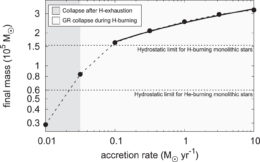Primordial supermassive stars might be responsible for the earliest supermassive black holes in our universe. But just how big can a star grow before it inevitably collapses into a black hole?
The Puzzle of Distant Quasars

Artist’s illustration of a high-redshift quasar, a black hole feeding on the material around it. [ESO/M. Kornmesser]
One theory is that these black holes formed from the direct collapse of stars. The larger the original star before collapse, the better the chances that the resulting black hole will be able to grow quickly. But even theorized Pop III stars (which have hundreds of solar masses) would have to accrete at rates higher than believed possible to achieve the black-hole masses we observe so quickly. For this reason, the commonly invoked explanation now is supermassive stars.
Early Giants
Supermassive stars are theoretical stars that formed in the very different environment of the early universe.

A composite infrared and X-ray image showing a molecular cloud and newly formed stars around Cepheus B. [X-ray: NASA/CXC/PSU/K. Getman et al.; IR: NASA/JPL-Caltech/CfA/J. Wang et al.]
In the supermassive star-formation scenario, hydrogen molecules in primordial halos are broken down — possibly by ultraviolet radiation from nearby star formation. This prevents the halos from cooling by molecular emission, instead allowing them to grow to an enormous 107–108 solar masses before they start cooling due to atomic emission. At this point they finally collapse to form a star.
Stars forming via this scenario quickly grow to be very massive, as the halo material falls onto the core at catastrophic rates of 0.01–10 solar masses per year. After a short period of this rapid accretion, the supermassive star then collapses into a black hole due to instability. But how massive could such a star grow before its collapse?
Simulating Growth
To answer this question, a team of scientists led by Tyrone Woods (Monash University, Australia) ran stellar-evolution simulations of the birth, growth, and eventual collapse of accreting, non-rotating supermassive stars. Their simulations included the effects of nuclear burning and captured the hydrodynamics of the instability that causes the stars to collapse into black holes, allowing the authors to follow the whole evolution.

The final mass at collapse of a star as a function of its accretion rate. Most stars collapse due to instability during hydrogen burning. [Woods et al. 2017]
This also sets the maximum mass of the supermassive black holes formed by direct collapse of stars in the early universe. At hundreds of thousands of solar masses, these first quasars provide much more plausible seeds than Pop III stars for growing the billion-solar-mass monsters we observe at high redshifts. Supermassive stars may indeed be the key to the formation of the first and most luminous quasars in our universe.
Citation
T. E. Woods et al 2017 ApJL 842 L6. doi:10.3847/2041-8213/aa7412

1 Comment
Pingback: Superstelle Primordiali | Accademia delle Stelle